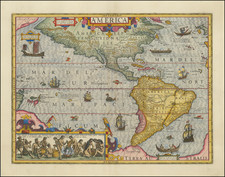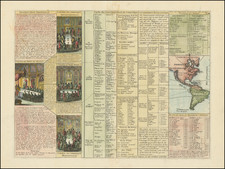Scarce map of America, published in Nuremberg at the end of the 18th Century.
The map shows North and South America on the eve of significant transformations. In North America, the map shows the Pacific Northwest at a moment in time when the Spanish, Russians, English and Americans were all trying to establish a firm foothold in the region. The Russians had established fur trading outposts in Alaska. The Hudson Bay Company was expanding its network of forts westward to the Rocky Mountains and beyond. The Spanish had established a firm present in Upper California and were sending expeditions north from Monterey to explore the Northwest Coast of America and assert sovereignty claims to compete with the Russians. At the same time, the United States was on the eve of acquiring the Oregon Territory as part of the Louisiana Purchase. Within a decade, the Pacific Northwest would be completely withdrawn.
As shown, the map reflects a wide open unexplored Pacific Northwest. San Francisco Bay is named, having been discovered by the Spanish in 1769 but having largely kept a secret until the 1790s when it began to appear on non-Spanish maps. The Upper Missouri River is taking shape. Two large lakes are shown west of the Rocky Mountains, one labeled "See" and one Teguayo". Most of the west is wide open. The United States, shown in Green, now includes the newly formed state of Kentucky.
In South America, continent is shown on the eve of several decades of Revolution, with Spain and Portugal still controlling most of the continent.
This map, a work of the German geographer Conrad Mannert, is drawn from the leading mapmakers of the period, including the second edition of Aaron Arrowsmith's world map on Mercator's Projection and Arrowsmith's world map on a globular projection, but adding in additional information from Jesuit missionaries and other travelers, alongside references from historians like Guillaume-Thomas Raynal and Johann Christoph Gatterer.










![[Nova et Acurata Totius Americae Tabula auct. G.I. Blaeu] America quarta pars orbis quam plerunq, novum orbem appellitant) primo detccta est anno 1492, a Christophoro Columbo Genuensi auspicijs Regis Castiliae, Deutde ulterius perucistigata navigationibus Americi Florentini, de cuius nomine America dicta est circiter annum 1497 Verum anno 1520 Ferdiandus Magallanus primus fuit qui extremos limites ad austru vergentes navigatione per fretum de nomine suo Magallanicu dictu uisitauit et noto fecit](https://storage.googleapis.com/raremaps/img/small/81465.jpg)
![[Sea of the West] L'Amerique divisee Par Grands Etats . . . 1762](https://storage.googleapis.com/raremaps/img/small/98770.jpg)
![[ Separately Published with Early Hand Drawn Addition of the Le Maire Strait ] Americae Sive Novi Orbis Nova Descriptio](https://storage.googleapis.com/raremaps/img/small/94478.jpg)
![America [Manuscript Map Showing the Sea of the West!]](https://storage.googleapis.com/raremaps/img/small/41297dm.jpg)
